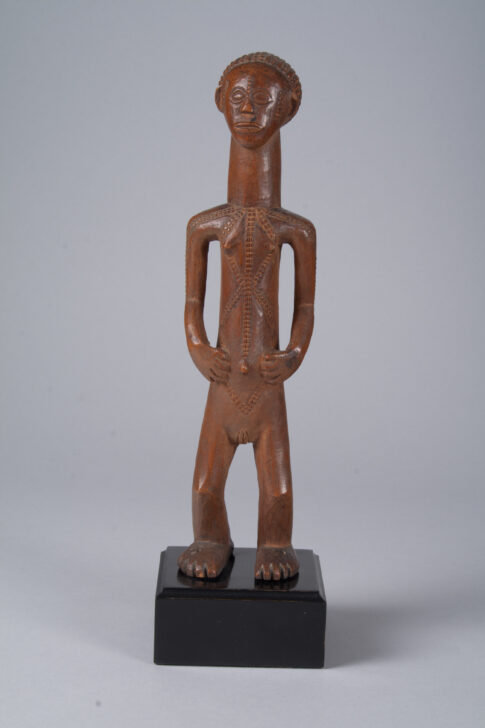Ancestor figure (female in Manda style)
Tabwa

Description
These finely carved figures, called MIKISI, represent a chief and his two wives. The figures refer both to the royal lineage of the chief who owned them, and to the culture hero Kyomba and his principle wives, who introduced chiefship and other important social institutions and technologies to Tabwa. Delicately detailed patterns of hair styling and scarification emphasize the body midline, which marks the thresholds between the symmetrical sides of the body. Right and left are symbolically opposed for Tabwa as for most of the world's peoples. A person bearing such a scarification pattern communicates the harmony of these opposing forces in his or her own being. Figures like these were kept in special spirit houses, where a chief would occasionally retire to sleep and have dreams inspired by the spirits they represented. Most such sculptures were destroyed during the colonial period, because of Christian proselytism, or have been sold to the Western art market. Today if Tabwa chiefs possess ancestral figures, they are made of clay and kept in utmost secrecy. The trio of figures now in the permanent collection of the University of Michigan Museum of Art is one of only a very few clusters of MIKISI in any public collection.
Subject Matter:
Representation of a female ancestor figure. The incised patterns on the figure mimic body scarification patterns then in use in Tabwa communities. The patterns are a kind of cosmogram: the symmetry and zigzag lines depict Tabwa conceptions of the relationships between the divine and earthly. Scarification is a kind of memory-making: the process of undergoing scarification creates a distinct mnemonic device, allowing the past to be quickly and vividly recalled in the present. In both skin and wood, the patterns associated with ancestral ties are made durable. The figure's coiffure is short and plaited, typical of Tabwa females, and denotes age and status.
Physical Description:
Carved wooden figure of a human. The torso, neck and head make an elongated cylinder along the certical axis. The hands rest at its sides near the umbilicus. The hair, face, hands, genitals, and feet are detailed.
Usage Rights:
If you are interested in using an image for a publication, please visit https://umma.umich.edu/request-image/ for more information and to fill out the online Image Rights and Reproductions Request Form.